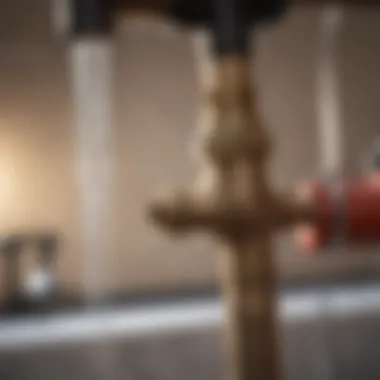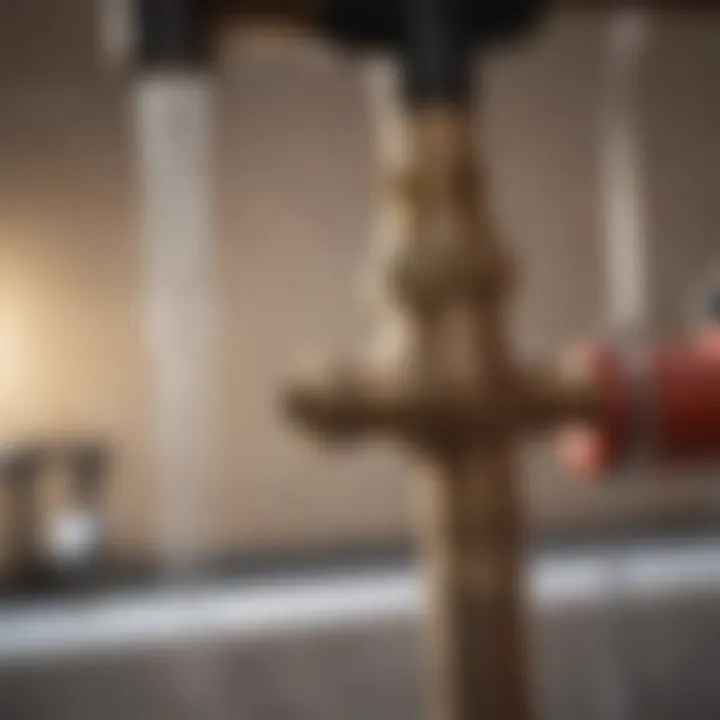Mastering the Art of Unclogging Water Pipes


Intro
Water pipes play a vital role in the infrastructure of any home. They carry water for drinking, cooking, and sanitation. However, it is not unusual to encounter clogs that disrupt this essential flow. Understanding how to effectively unclog water pipes is crucial for maintaining a functional plumbing system. This guide offers a detailed examination of the causes of clogs, effective techniques to resolve them, and methods to prevent future problems.
Common Causes of Blockages
There are various reasons why water pipes become clogged. Some common culprits include:
- Hair: Particularly in bathroom drains, hair can build up over time.
- Grease: Kitchen sink clogs often arise from grease and food residue.
- Soap Scum: Soap can create a residue over time which hardens and obstructs flow.
- Foreign Objects: Items like toys or other debris can accidentally enter pipes.
Identifying the source of the blockage is the first step in addressing the issue.
Techniques for Unclogging
There are several methods for unclogging water pipes, ranging from simple DIY solutions to professional interventions:
DIY Approaches
- Boiling Water: Pouring boiling water down the drain can sometimes dissolve minor blockages, especially grease.
- Baking Soda and Vinegar: This combination can create a reaction that helps break down clogs.
- Plunger: A traditional tool that can effectively dislodge stubborn blockages.
- Snake Tool: This tool can reach deeper into the pipes to eliminate the obstruction.
Professional Techniques
- Hydro Jetting: This involves using high-pressure water to clear out the pipe.
- Camera Inspection: A camera can help locate the exact source of the clog, allowing for precise actions.
It is advisable to seek professional assistance for severe or persistent clogs to avoid damage to the plumbing system.
Preventative Measures
Taking steps to prevent clogs can save time and money in the long run. Key strategies include:
- Regular Cleaning: Maintain pipes by routinely cleaning sinks and drains.
- Using Strainers: Installing strainers can prevent hair and food waste from entering the pipes.
- Avoiding Chemical Drain Cleaners: These can damage pipes over time and create more problems.
- Educating Family Members: Make sure everyone understands what should not go down the drain.
By implementing these measures, homeowners can promote the longevity of their plumbing system.
"Preventative maintenance is key to ensuring the efficiency of your plumbing system and avoiding costly repairs in the future."
Finale
Understanding the fundamentals of unclogging water pipes allows for effective responses to common plumbing issues. Whether employing DIY methods or seeking professional help, knowledge in this area is essential. Through proactive maintenance and informed actions, one can offset potential problems and ensure the integrity of the plumbing system.
Preamble to Water Pipe Clogging
Understanding how water pipes become clogged is essential for maintaining the functionality and integrity of a plumbing system. Clogs can lead to a range of issues, including poor drainage, unpleasant odors, and, in severe cases, pipe damage. This section outlines the significance of knowing about water pipe clogs and introduces the basic concepts surrounding the topic.
Understanding Water Pipes
Water pipes are critical infrastructures in residential and commercial buildings. They transport water for everyday use, such as drinking, cooking, and sanitation. Common materials used for these pipes include polyvinyl chloride (PVC), copper, and galvanized steel. Each type of material comes with its advantages and disadvantages, affecting longevity and susceptibility to clogs. Understanding their structure and flow dynamics can aid homeowners and maintenance workers in recognizing potential risks that may lead to blockages.
Proper maintenance is key to preventing water pipe clogs. Regular checks and repairs can save property owners significant time and expense. Knowledge about water pipe systems empowers users to detect warning signs early and address minor problems before they escalate into major plumbing issues.
Common Causes of Clogs
A variety of factors can contribute to blockages in water pipes. Knowing the common causes of clogs can help one to implement preventive actions. The following are notable causes:
- Hair and Soap Residues: In shower and bath drains, hair combines with soap scum to form significant blockages.
- Food Waste: Kitchen sinks can become clogged due to residual food particles, particularly from fibrous or starchy foods.
- Grease Accumulation: Lucid grease poured down the sink can solidify over time and collect debris, leading to severe clogs.
- Foreign Objects: Items not meant for disposal, such as paper towels or wipes, can easily cause obstructions.
- Mineral Build-up: Hard water can lead to mineral deposits that accumulate inside pipes, narrowing their diameter and restricting water flow.
Recognizing these common culprits enables proactive interventions, such as avoiding the disposal of certain items in sinks and regularly cleaning drains. In doing so, the chances of encountering severe clogs can be greatly reduced.


Understanding the potential causes and dynamics of pipe blockages is invaluable. It not only helps prevent costly repairs but also enhances the longevity of plumbing systems.
Identifying Blockages
Identifying blockages in water pipes is crucial to maintaining the overall functionality of plumbing systems. It allows homeowners, property managers, and maintenance professionals to address issues before they become severe and costly. Recognizing early signs of clogs can prevent further damage and extend the lifespan of pipes. Blockages can lead to pressure build-up, which may result in leaks or bursts. Therefore, understanding how to spot these issues early can save both time and money.
Signs of a Clogged Pipe
Identifying a clogged pipe can often be done through a few clear indicators. Here are some common signs:
- Slow drainage: Water takes longer to drain than usual in sinks, baths, or showers. This typically signals that a blockage is developing.
- Gurgling sounds: Strange noises coming from the plumbing can indicate air trapped in the pipes or water struggling to move past a clog.
- Unpleasant odors: Foul smells emanating from drains can suggest decomposing debris in the pipes.
- Backflow concerns: Water or sewage may backflow into sinks or tubs if serious blockages are present.
These signs are important to note. If they occur consistently, it may be time to inspect further.
Assessing Severity of the Clog
Not all blockages are equal, and assessing the severity is essential for determining the appropriate course of action. Here are some methods to evaluate the situation:
- Visual Inspection: Inspect exposed pipes for any water stains, rust, or corrosion, which can signal existing issues.
- Water Flow Test: Turn on the tap and observe the flow rate. A significant drop in flow indicates a severe blockage.
- Check Multiple Fixtures: If several sinks or toilets are draining slowly, the clog might be more extensive, affecting a main pipe or sewer line.
Recognizing high-risk scenarios is vital. If a clog is confirmed as severe, professional assistance may be necessary to prevent further damage or complications.
Tools and Materials for Unclogging
Unclogging water pipes can be a daunting task, but having the right tools and materials makes this process significantly more manageable. Understanding the utility of various equipment allows homeowners and professionals alike to act swiftly and effectively, reducing frustration and potential damage. This section will discuss essential tools, chemical solutions, and the use of plumbing snakes, emphasizing their roles in unclogging and maintaining water pipes.
Essential Tools
When it comes to unclogging pipes, several tools are indispensable. These tools vary in complexity and application, which can affect their overall efficiency. Some of the fundamental tools include:
- Plunger: A classic and effective tool, ideal for dislodging minor clogs in toilets and sinks.
- Pipe Wrench: Useful for gripping and turning pipes when they need to be removed or inspected.
- Auger: An advanced tool that can reach blockages that are deeper in the system, providing a more thorough cleaning.
- Gloves: Protecting your hands is essential when engaging in any plumbing task. A good pair of rubber gloves can also provide grip.
- Bucket: Having a bucket on hand catches any residual water or debris that might spill out during the unclogging process, making cleanup easier.
Equipping yourself with these tools not only streamlines the work but also ensures that you are prepared for various clog scenarios.
Chemical Solutions
In some cases, mechanical methods alone might not suffice. Chemical solutions can be effective for breaking down grease, hair, and other organic materials that cause clogs. However, caution is paramount due to potential damage to pipes and the environment. Common chemical solutions include:
- Drain Cleaners: These products often contain harsh chemicals designed to dissolve clogs. Their effectiveness depends on the type of blockage.
- Enzymatic Cleaners: These are safer for the environment and work by using enzymes to break down organic matter. They require time to be effective, so patience is necessary.
When using chemical solutions, always follow the manufacturer’s instructions carefully. Improper use can lead to more significant plumbing issues or hazards.
Using a Plumbing Snake
A plumbing snake is one of the most effective tools for tackling tough clogs in drains and pipes. This flexible tool can navigate through bends and turns in plumbing systems, reaching blockages that are unreachable by plungers. Here is how to use it:
- Insert the Snake: Start by feeding the snake slowly into the drain. You may need to turn the handle for better entry.
- Advance the Snake: Push the snake forward until you encounter resistance, indicating the clog.
- Break the Clog: Rotate and push the snake gently. This action helps to break apart and dislodge the clog.
- Remove the Snake: Once you feel the resistance lessen, carefully retract the snake while ensuring any debris is collected.
Using a plumbing snake effectively can save time and restore flow in the pipes. This method is a preferred technique among professionals for effectively dealing with stubborn blockages.
Proper tools and chemicals are vital for effective unclogging efforts, reducing the likelihood of plumbing mishaps in the future.
In summary, understanding the tools and materials available aids in effectively tackling clogged water pipes. Choosing the right equipment can enhance efficiency, safeguard your plumbing system, and ultimately lead to improved water flow. With this knowledge, you are now better prepared to address clogs as they arise.
DIY Unclogging Techniques
Unclogging water pipes can often be achieved without the need for professional help. This section outlines some effective DIY techniques for addressing blockages. These methods empower homeowners to take charge of their plumbing issues. Not only do they save costs but also promote a sense of accomplishment. Understanding the advantages and disadvantages of each method is essential for any DIY enthusiast.


Boiling Water Method
The boiling water method is one of the simplest yet effective techniques to tackle minor clogs. It works particularly well on grease buildup in kitchen sinks. You just need to boil a pot of water, then pour it slowly down the drain. The heat helps dissolve grease, allowing water to flow freely.
Steps for the Boiling Water Method:
- Boil water: Bring a pot of water to a rolling boil.
- Prepare area: Clear away any items from around the sink or drain.
- Pour carefully: Slowly pour the boiling water into the drain in three stages, allowing it to work between pours.
- Monitor progress: Wait a few minutes to see if water drains better.
This method is straightforward. However, it may not be effective for stubborn clogs. It is not recommended for PVC pipes, as the heat may cause damage.
Baking Soda and Vinegar
The combination of baking soda and vinegar offers a natural alternative to chemicals for unclogging pipes. This technique relies on a simple chemical reaction. When mixed, these ingredients create carbon dioxide, which can help loosen debris blocking the pipes.
Procedure:
- Measure ingredients: Pour half a cup of baking soda down the drain.
- Add vinegar: Quickly follow with half a cup of vinegar.
- Cover drain: Use a stopper or cloth to cover the drain, trapping the reaction inside.
- Wait: Allow the mixture to sit for about 30 minutes.
- Flush with hot water: Finish by flushing the drain with boiling water.
This method is effective and non-toxic, making it an ideal choice for environmentally conscious homeowners. Still, it requires regular repeat treatments for best results.
Manual Removal of Clogs
Sometimes, the best way to unclog a pipe is by manual removal. This technique is labor-intensive but can be very effective, especially for solid blockages. Here are some options:
- Use of gloves: Always wear rubber gloves to protect your hands.
- Remove drain cover: If applicable, remove any drain cover or stopper.
- Inspect with a flashlight: Check for visible debris that can be reached.
- Use tools: A pair of pliers can grasp items that are reachable.
If a clog is deep within the pipe, this method might not work effectively. Sometimes, it may require specific tools like a drain auger. Avoid pushing debris further down, which can worsen the clog.
It's important to remember that some methods may be more effective than others depending on the nature of the clog.
Focusing on these techniques allows for an informed approach to common plumbing issues. Homeowners can adopt and adapt these methods based on their specific needs.
When to Seek Professional Help
Water pipes can become clogged for various reasons. While many clogs can be resolved through DIY methods, some situations warrant the intervention of a professional plumber. Understanding when to seek professional help is crucial. Trying to resolve complex plumbing issues without the right knowledge can lead to further damage and costly repairs.
Identifying Complex Blockages
In some cases, blockages may not be easily accessible. Factors such as the location of the clog or the type of plumbing system can complicate removal.
- Location of the Clog: If the clog is deep within the system, it might not be feasible to reach it with standard tools.
- Material Build-up: Over time, pipes can accumulate materials that are difficult to remove. This could include roots from nearby trees or grease from kitchen waste.
- Multiple Clogs: If there are clogs in multiple areas of the system, it may indicate a larger issue that requires expertise.
Signs of complex blockages might include persistent slow drainage, multiple affected fixtures, or recurring blockages despite attempts at resolution. Recognizing these signs can help determine the right moment to call a professional.
Risks of DIY Attempts
DIY solutions, while attractive due to the potential cost savings, carry risks. Without adequate knowledge, one might inadvertently worsen the clog or damage the plumbing system. Here are several dangers to consider:
- Pipe Damage: Using improper tools can lead to cracks or leaks in your pipes, resulting in extensive water damage.
- Health Hazards: Some blockages may involve hazardous materials. Attempting to clear these without proper safety protocols can pose health risks.
- Time Consumption: DIY attempts may fail, leading to more time lost than hiring a professional would take.
- Financial Implications: The initial savings from a DIY approach could be overshadowed by costly repairs or the need for professional help afterward.
Preventative Measures
Preventative measures are crucial for maintaining water pipes and avoiding the inconveniences posed by blockages. Clogs often result from neglecting proper maintenance, leading to costly repairs and damage to plumbing systems. By implementing regular upkeep routines and mindful disposal practices, homeowners can significantly reduce the frequency and severity of clogs. It is much easier and less expensive to prevent issues rather than deal with them once they arise.
The importance of preventative measures can be summed up in several key points:
- Cost Efficiency: Regular maintenance can save money in the long run by avoiding emergency plumbing services.
- Pipe Longevity: Keeping pipes well-maintained extends their lifespan, ensuring that replacements and repairs are infrequent.
- Water Quality: Properly maintained pipes contribute to better water quality by preventing contamination stemming from clogs.


Adopting a proactive approach helps create a more efficient water delivery system, benefiting homeowners and their property as a whole.
Regular Maintenance Practices
Regular maintenance practices play a significant role in preventing clogs in water pipes. These practices encourage vigilance and periodic checks that can identify potential issues early on. One effective strategy is to schedule annual inspections of the plumbing system by a professional. During these inspections, a technician can check for wear, tear, and potential buildup in the pipes.
Homeowners can also perform simple maintenance. Here are some recommendations:
- Routine Flushing: Consider flushing the pipes periodically with boiling water to help prevent buildup.
- Monitor Drains: Keep an eye on your drains and observe any changes in water flow.
- Catchers and Strainers: Use strainers in sinks and baths to catch debris and prevent it from entering the pipes.
These practices do not take much time or effort but can significantly decrease the occurrence of clogs and maintain a healthy plumbing system.
Best Practices for Waste Disposal
Proper waste disposal is integral to preventing clogs in water pipes. A common cause of clogging is the improper disposal of items that should not go into the plumbing system. It is essential to educate all household members about what is safe to flush and what is not.
Here are several best practices for waste disposal to keep in mind:
- Avoid Flushing Non-Biodegradables: Never flush items like wipes, feminine hygiene products, or paper towels, as they do not disintegrate like toilet paper.
- Dispose of Grease Properly: Grease can solidify and cause significant blockages. Instead of pouring it down the drain, let it cool and dispose of it in the trash.
- Food Scraps: If you have a garbage disposal, use it sparingly. Large food scraps can lead to issues. Composting is a better alternative for many food residues.
Implementing these practices is an actionable approach towards maintaining clear and functional pipes in the long run. By being conscientious about disposal habits, homeowners can greatly reduce the likelihood of clogs.
Environmental Considerations
Understanding the environmental impact of plumbing practice is often overlooked. When dealing with clogs, the methods we choose to resolve them can have significant repercussions on our ecosystems. In this article, it becomes crucial to highlight eco-friendly alternatives as part of a responsible approach to plumbing. The aim is to minimize the use of harsh chemicals that not only damage pipes over time, but also contaminate water systems.
Eco-Friendly Cleaning Solutions
Choosing cleaner alternatives goes a long way in ensuring that we protect our waterways. Many commercial drain cleaners contain harmful substances. These harsh chemicals can, with time, lead to pipe degradation or damage natural resources.
Instead, consider some eco-friendly solutions:
- Baking Soda and Vinegar: This combination is a popular choice for homeowners. The fizzing reaction helps to dislodge small clogs.
- Salt and Hot Water: Salt can act as a natural abrasive. When it's combined with hot water, it can help clear build-up in pipes.
- Biodegradable Products: Brands that focus on sustainability often provide cleaning agents that are safe for the environment. These solutions target clogs without causing long-term harm.
Introducing these methods into regular maintenance routines can significantly reduce the need for professional intervention.
Impact of Blockages on Water Systems
Blockages do not only affect individual properties; they also pose a risk to larger water systems. When pipes are clogged, wastewater can back up and overflow. This creates unsanitary conditions, which can lead to pathogen spread. Furthermore, clogged systems pressure water treatment facilities, which can result in operational failures.
Over time, this impacts the quality of the water supply.
Consider the following points regarding the consequences of untreated blockages:
- Increased Pollution: Backed-up wastewater may spill into natural bodies of water, affecting local wildlife and ecosystems.
- Financial Strain: Local governments may face increased costs from clean-up efforts. These funds could be utilized more effectively in sustainable projects.
- Public Health Risks: The overflow of sewage water introduces various health hazards for communities.
Regular maintenance and the use of eco-friendly cleaning solutions not only promote the longevity of pipes but also contribute to a healthier environment.
By addressing how clogs affect not just our own plumbing but the greater ecosystem, we can adopt a more holistic approach to our plumbing issues. Maintaining pipes responsibly impacts not only personal plumbing but the larger environment as well.
Epilogue and Summary
Effective management of water pipe clogging is essential for maintaining the functionality and longevity of plumbing systems. Understanding the different factors contributing to clogs can significantly impact how individuals address these issues. This article has provided an in-depth exploration of various strategies for unclogging water pipes. The significance of this topic cannot be understated, as the costs associated with plumbing repairs and potential water damage can escalate quickly if issues are not properly managed.
Recap of Key Points
In this article, we delved into the following crucial aspects:
- Understanding Water Pipe Clogging: We discussed what water pipes are and the common causes of clogs, which include debris accumulation and improper waste disposal.
- Identifying Blockages: We outlined key indicators that signal a clogged pipe and how to assess the severity of the blockage.
- Tools and Materials for Unclogging: Essential tools such as plungers and chemical solutions were highlighted to equip individuals for effective unclogging.
- DIY Unclogging Techniques: Various methods like using boiling water and the combination of baking soda and vinegar were detailed as practical, safe approaches.
- When to Seek Professional Help: We emphasized scenarios where professional intervention is crucial, especially for complex blockages that might risk further plumbing issues.
- Preventative Measures: Regular maintenance practices were discussed as proactive steps to prevent clogs from occurring in the first place.
- Environmental Considerations: The importance of eco-friendly cleaning solutions and the impact of blockages on water systems were examined to promote sustainable practices.
Final Thoughts
Clogged water pipes can lead to frustrating and costly issues. However, with the right information and tools, many clogging problems can be addressed efficiently. It is vital to understand both the immediate fixes and long-term preventative measures.
Taking proactive steps to maintain your plumbing system will enhance its overall health and reduce the likelihood of blockages. Seeking the proper balance between DIY techniques and professional advice will ensure a resilient plumbing system that serves its purpose effectively. Armed with the insights provided in this article, readers are better prepared to manage their water pipes with confidence and care.







